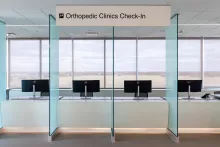Spinal Stenosis
- For Orthopedics and Rehabilitation related requests:
- 1-319-356-2223
- For Neurosurgery related requests:
- 1-319-356-2237
Lumbar spinal stenosis can lead to pain, numbness, and weakness that can be debilitating, but University of Iowa Health Care experts can provide relief.
Our neurosurgeons and orthopedic surgeons have special expertise in diagnosing and treating spinal stenosis.
The cause of spinal stenosis and the best way to treat it can be difficult to pinpoint. The amount of experience your specialist has with spine conditions is critical for your effective treatment and recovery.
If you need surgery, you also need an experienced spine surgeon in order to have the best outcome. The UI Health Care team has deep experience in diagnosing and treating spinal stenosis and other conditions.
Spinal stenosis symptoms and diagnosis
Your spine is made up of a line of bones called vertebrae that surround and protect your spinal cord. Spinal stenosis is narrowing of the space around your spinal cord and nerves.
The spinal cord contains nerves that branch out to all parts of your body. It runs down the center of your spine.
A healthy spine has enough space to accommodate the nerves it protects.
This can happen in your back or neck, in three locations:
- The column in the spine that contains the spinal cord
- Openings in the vertebrae where nerves branch out from the spinal cord
- Gaps between the vertebrae
Spinal stenosis usually affects people over age 50. Causes include:
- Arthritis that leads to bone spurs created by wear and tear on the spine
- Herniated discs
- Scoliosis
- Spinal tumors
- Spinal cord injury
- Thickened ligaments that bulge into the spinal canal
Younger people who were born with a small spinal canal or have had a spine injury may also be at risk for spinal stenosis.
Symptoms of spinal stenosis often start slowly and grow worse over time. Common symptoms include:
- Neck or back pain
- Sciatica, or pain that radiates from your low back through your buttock and the back of your leg
- Numbness, tingling, or pain in your arms or legs
- Pain or cramping in your legs when walking or standing
- Foot pain
- Weakness in your arms, legs or feet
In some severe cases, spinal stenosis can affect control of bowel, bladder, and sexual functions.
Your physician will examine you and talk with you about the symptoms and pain you're experiencing.
You may have imaging to show where your nerves are being compressed, such as:
- X-rays
- MRI
- CT scan
The images will also show any bone spurs or damaged discs. Our state-of-the-art imaging equipment shows your providers exactly where the problems are.
You may also have an electromyelogram (EMG) or nerve conduction study, to see how your nerves are affected by stenosis.
Spinal stenosis treatment from UI Health Care
The treatment your doctor recommends for spinal stenosis will depend on what's causing your symptoms and how severe they are.
A team of spine experts
UI Health Care's spine surgery team of neurosurgeons and orthopedic surgeons performs decompression surgery. They will work together on your care if your surgery is complex.
Your care team might also include specialists in radiology, spine rehabilitation, physical medicine and rehabilitation, pain medicine, and other areas. They work together to create a personalized plan of care for relieving your pain and restoring your quality of life.
Nonsurgical treatment
Most people can get relief from spinal stenosis pain without having surgery. Options include:
- Medications such as nonsteroidal anti-inflammatory drugs (NSAIDs, including ibuprofen and naproxen), muscle relaxants, and some antidepressants to help control pain
- Steroid injections to temporarily reduce inflammation and relieve pressure when pinched nerve roots become irritated and swollen
- Physical therapy will teach you special exercises. Your therapy plan will be designed to maintain the flexibility and stability of your spine and improve your strength and endurance.
Spine surgery for spinal stenosis
Surgery might be the best option for spinal stenosis treatment if other treatments don't work, or if large bone spurs are blocking your spinal canal.
This kind of procedure is called decompression surgery. It relieves the pressure on the spinal cord or nerves by creating more space for them.
In some cases, decompression surgery can be performed in a minimally invasive way, using special tools inserted through small incisions. Minimally invasive surgery means less pain, fewer complications, and faster recovery. Ask your surgeon if this minimally invasive option is right for you.
- Laminectomy is the most common surgery for spinal stenosis. This procedure removes all or part of the vertebral bone (lamina), creating more space for the spinal cord.
- Spinal fusion might be performed along with your laminectomy. This means placing a bone graft or metal implants alongside the vertebrae to stabilize your spine.
- Foraminotomy removes a bone spur or herniated disc that's blocking the opening between your vertebrae.
- Laminoplasty might be performed if stenosis is in your neck, or cervical spine. Your surgeon cuts the vertebra to create a hinge on one side. The other side is then propped open with a spacer.
Our Care Team















- Orthopedics and Rehabilitation

Need a second opinion about your spinal stenosis diagnosis?
Locations and Offices

